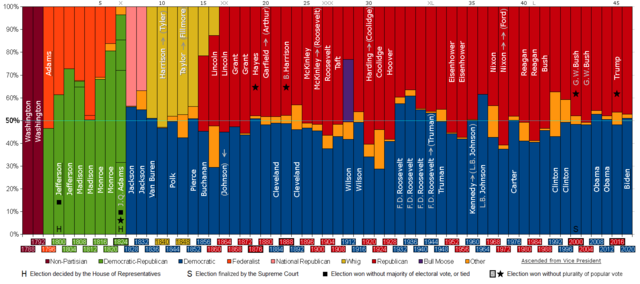Top Qs
Timeline
Chat
Perspective
List of United States presidential elections by popular vote margin
From Wikipedia, the free encyclopedia
Remove ads
In a United States presidential election, the popular vote is the total number or the percentage of votes cast for a candidate by voters in the 50 states and Washington, D.C.; the candidate who gains the most votes nationwide is said to have won the popular vote. As the popular vote is not used to determine who is elected as the nation's president or vice president, it is possible for the winner of the popular vote to end up losing the election, an outcome that has occurred on five occasions, most recently in 2016. This is because presidential elections are indirect elections; the votes cast on Election Day are not cast directly for a candidate but for members of the Electoral College. The Electoral College's electors then formally elect the president and vice president.[3][4]
This article needs additional citations for verification. (March 2020) |

The Twelfth Amendment to the United States Constitution (1804) provides the procedure by which the president and vice president are elected; electors vote separately for each office. Previously, electors cast two votes for president, and the winner and runner up became president and vice-president respectively. The appointment of electors is a matter for each state's legislature to determine; in 1872 and in every presidential election since 1880, all states have used a popular vote to do so.
The 1824 election was the first in which the popular vote was first fully recorded and reported. Since then, 19 presidential elections have occurred in which a candidate was elected or reelected without gaining a majority of the popular vote.[5] Since the 1988 election, the popular vote of presidential elections has been decided by single-digit margins, the longest streak of close-election results since states began popularly electing presidents in the 1820s.[6]
Remove ads
List
| Parties: Federalist • Democratic-Republican • National Republican • Whig • Democratic • Republican • Progressive • Independent |
| Vote outcomes: Winner received only a plurality of the popular vote • Winner lost the popular vote • Winner chosen by the House of Representatives |
- Washington ran unopposed and was unanimously elected in both elections; John Adams received the majority of electors' second votes and became vice-president.
- Jefferson and Burr ran on the same ticket, and Jefferson's main election rival in the 1800 election was incumbent president and Federalist candidate John Adams. Due to the Democratic-Republicans failing to arrange for a different candidate to receive what was Burr's 73rd electoral vote, the election was decided by the House, which eventually elected Jefferson on the 36th ballot. The Twelfth Amendment was later enacted to prevent a recurrence of the issue.
- While commonly labeled as the Federalist candidate, Clinton ran as a Democratic-Republican and was not nominated by the Federalist party itself, the latter simply deciding not to field a candidate. This did not prevent endorsements from state Federalist parties, such as in Pennsylvania; he also received endorsements from state Democratic-Republican parties, such as in New York.
- The 1820 election took place at the height of the Era of Good Feelings, and Monroe did not face serious opposition, although 16% of the popular vote went towards unpledged Federalist electors. Adams's only electoral vote came from a faithless elector.
- Jackson won a plurality of electoral votes (99 compared to Adams's 84) but lost due to Adams securing a majority of state delegations in the contingent election.
- Breckinridge was the runner up in the electoral vote, while Stephen A. Douglas was the runner up in the popular vote.
- The initial Democratic-backed candidate, Horace Greeley of the Liberal Republican Party), died between the popular election and the meeting of electors; his electoral college votes scattered, with Hendricks gaining 42 of the 66 electors previously committed to Greeley.
Remove ads
Timeline

A gray arrow points to the name of a person who became president without having been elected as president (9 total). The double arrow indicates becoming president without having been elected as vice president (e.g. Ford). 5 other former vice presidents are underlined (14 total). The top line indicates the presidency number (e.g. 40th for Reagan) with Roman numerals indicating election and term number.
Remove ads
See also
References
Bibliography
External links
Wikiwand - on
Seamless Wikipedia browsing. On steroids.
Remove ads
